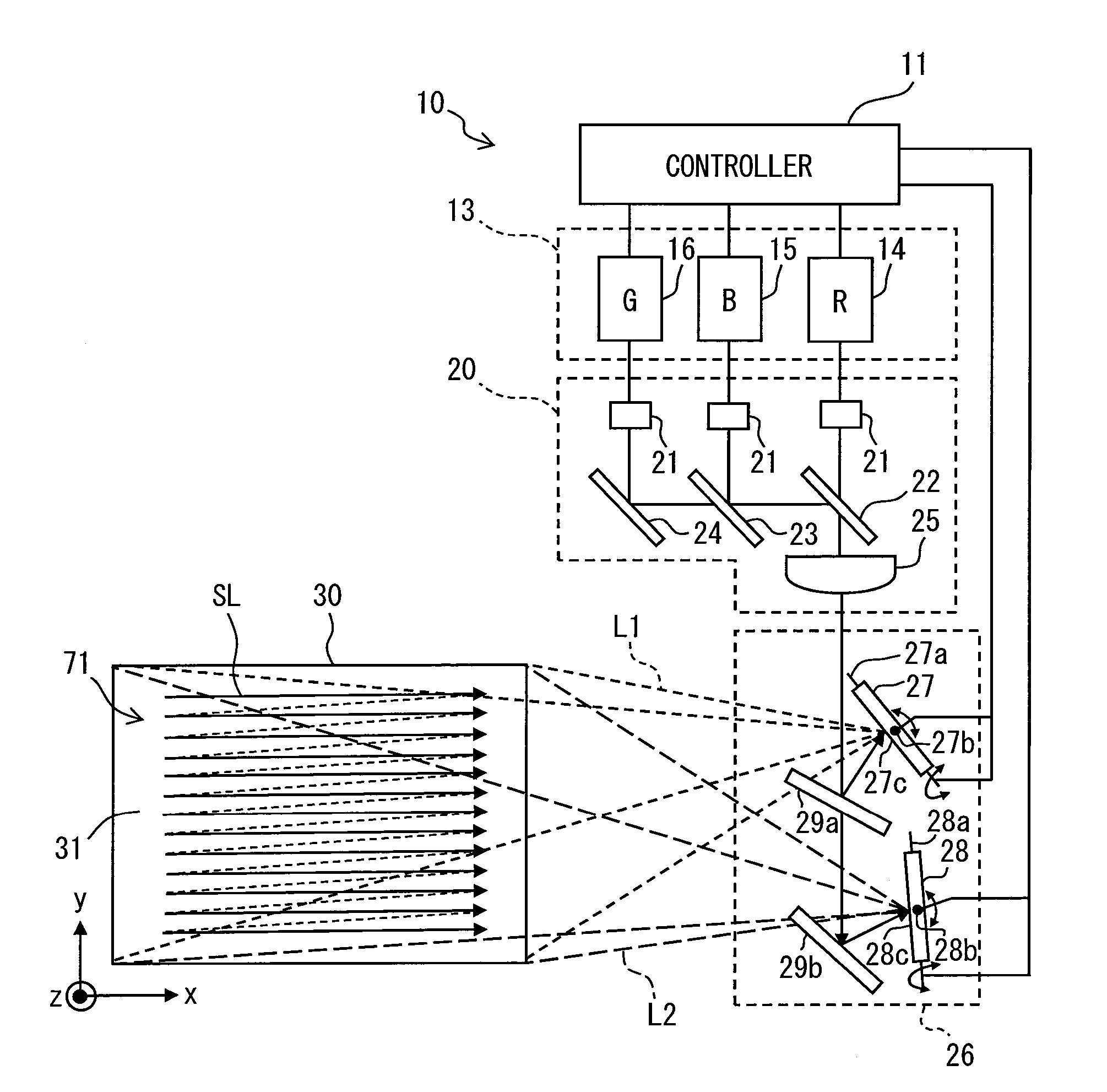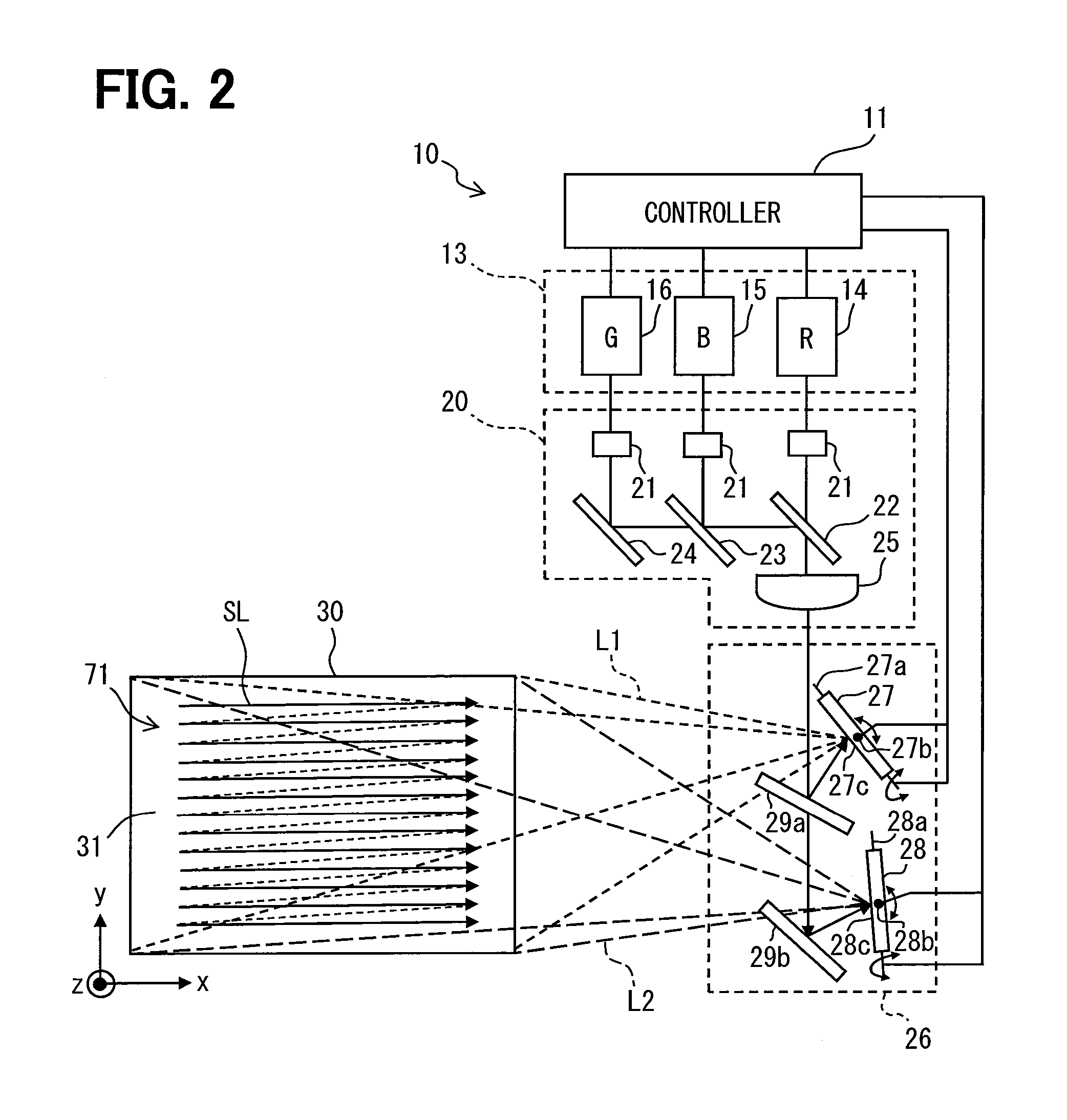Head-up display device
a display device and head-up technology, applied in the direction of lenses, instruments, transportation and packaging, etc., can solve the problems of unfavorable uniform virtual image and inability to configure the micro lens array, and achieve the effect of simple screen member configuration and reduction of uneven virtual imag
- Summary
- Abstract
- Description
- Claims
- Application Information
AI Technical Summary
Benefits of technology
Problems solved by technology
Method used
Image
Examples
first embodiment
[0029]Parts A and B in FIG. 1 illustrate a head-up display device 100 according to the first embodiment. The head-up display device 100 is contained in an instrument panel 80 of a vehicle, for example. A display image 71 penetrates a translucent dust prevention cover 50 that covers an aperture 51. The head-up display device 100 projects the display image 71 onto a display member such as a windshield 90 of the vehicle and allows a virtual image 70 of the display image 71 to be visible from a predetermined eye box 60. The eye box 60 is sized 100 through 200 millimeters horizontally and 40 through 90 millimeters vertically, for example. A projection plane 91 is formed on the surface of the windshield 90 on a vehicle compartment side. The head-up display device 100 projects the display image 71 onto the projection plane 91. The light of the display image 71 is projected onto the concavely curved projection plane 91 that then reflects the light to the eye box 60. The light reaches a view...
second embodiment
[0055]The second embodiment illustrated in FIGS. 8 and 9 is a modification of the first embodiment. As illustrated in FIG. 8, a MEMS mirror portion 226 according to the second embodiment includes half mirrors 29a and 229a, the mirror reflector 29b, the first scanner 27, the second scanner 28, and a third scanner 227. The half mirror 29a reflects approximately one third of a laser beam irradiated from the optical portion 20 to the first scanner 27 and transmits the remainder, i.e., approximately two thirds of the laser beam to the half mirror 229a. The half mirror 229a is configured to be substantially equal to the half mirror 29a and is placed so that the reflection surface faces the mirror 29a and the third scanner 227. The half mirror 229a reflects approximately half the laser beam penetrating the half mirror 29a to the third scanner 227 and transmits the remainder, i.e., approximately half the laser beam to the mirror reflector 29b. The half mirror 29a and 229a and the mirror ref...
third embodiment
[0062]The third embodiment illustrated in FIGS. 10 through 14 is another modification of the first embodiment. In a laser scanner 310 illustrated in FIG. 10, a MEMS mirror portion 326 includes a horizontal scanner 327 and a vertical scanner 328 connected to the controller 11. The horizontal scanner 327 and the vertical scanner 328 are provided with rotation axes 327a and 328a and MEMS reflection surfaces 327b and 328b, respectively. The MEMS reflection surfaces 327b and 328b each contain a metal thin film formed by depositing aluminum.
[0063]The horizontal scanner 327 is placed so that the reflection surface 327b faces the optical portion 20 and the vertical scanner 328. Based on a drive signal from the controller 11, the horizontal scanner 327 rotationally displaces the MEMS reflection surface 327b around the rotation axis 327a. The vertical scanner 328 is placed so that the MEMS reflection surface 328b faces the MEMS reflection surface 327b of the horizontal scanner 327 and a scree...
PUM
 Login to View More
Login to View More Abstract
Description
Claims
Application Information
 Login to View More
Login to View More - R&D
- Intellectual Property
- Life Sciences
- Materials
- Tech Scout
- Unparalleled Data Quality
- Higher Quality Content
- 60% Fewer Hallucinations
Browse by: Latest US Patents, China's latest patents, Technical Efficacy Thesaurus, Application Domain, Technology Topic, Popular Technical Reports.
© 2025 PatSnap. All rights reserved.Legal|Privacy policy|Modern Slavery Act Transparency Statement|Sitemap|About US| Contact US: help@patsnap.com



